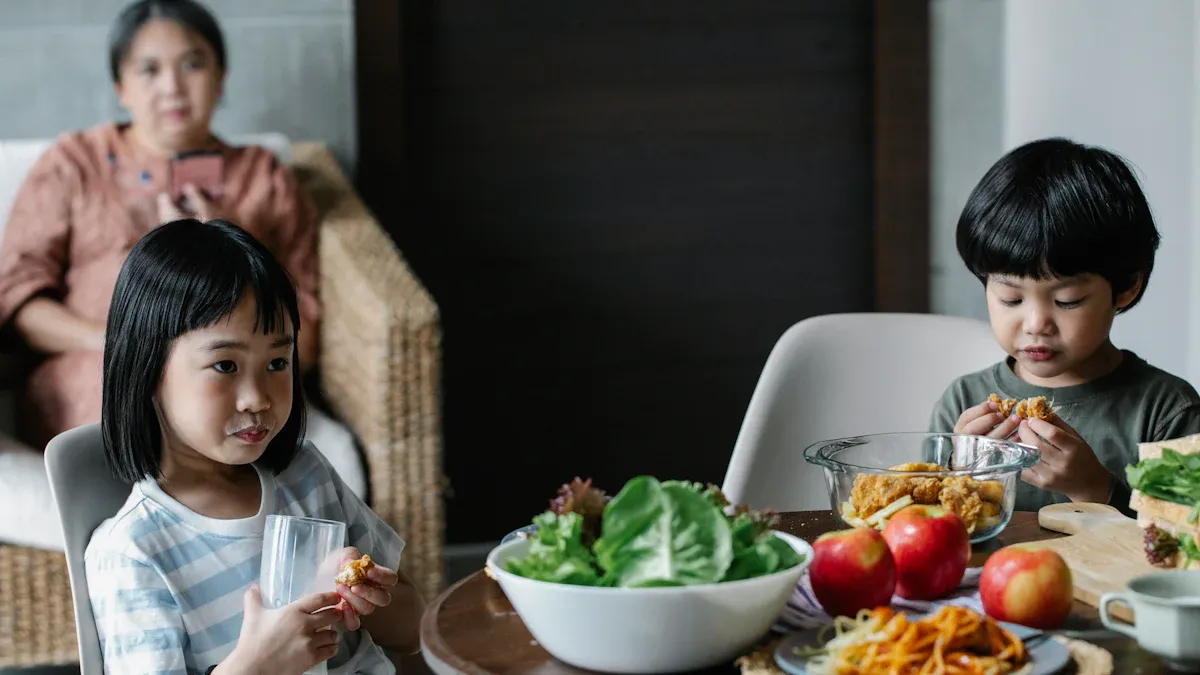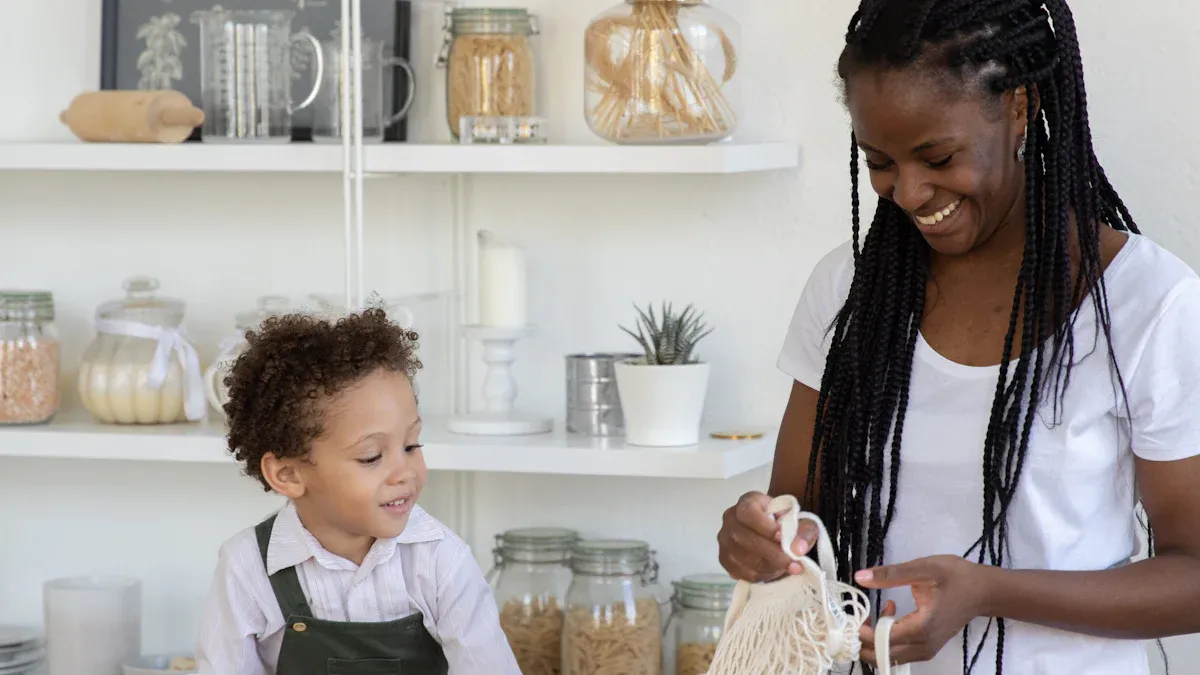
You want your kids to eat from safe, natural plates every day, and bamboo childrens plates are the perfect solution. Bamboo childrens plates give you peace of mind because this bamboo tableware contains no harmful chemicals. These bamboo childrens plates protect your children’s health and keep mealtime worry-free. By choosing bamboo childrens plates, you support eco-friendly products and enjoy real environmental benefits. Bamboo childrens plates stand out as a sustainable, environmentally responsible choice. With every meal, you help your kids and the planet by choosing bamboo childrens plates.
Safety Benefits of Bamboo Children’s Plates

Non-Toxic and Chemical-Free Bamboo Tableware
You want your kids to eat from plates that are truly non-toxic. Bamboo tableware gives you that peace of mind. Unlike many plastic or melamine plates, bamboo childrens plates do not contain harmful chemicals that can leach into food. Scientific tests use advanced methods like ultra-performance liquid chromatography–tandem mass spectrometry (UPLC–MS/MS) to check for chemical migration in bamboo tableware. These tests look for substances like melamine and formaldehyde, which can pose health risks if present in high amounts. Some bamboo plates on the market may contain these chemicals, but when you choose high-quality bamboo tableware from trusted brands, you protect your children from these dangers. Manufacturers use special processes, such as wax annealing, to make bamboo plates non-toxic and durable. This means you can serve hot or cold meals without worrying about your kids’ dinnerware releasing unsafe substances. You keep your family’s health at the center of every meal.
Tip: Always choose bamboo childrens plates from reputable suppliers who follow strict safety standards. This ensures your kids’ dinnerware is truly non-toxic and chemical-free.
Antimicrobial and Antibacterial Properties
Bamboo tableware stands out because it naturally fights bacteria. Scientific research shows that bamboo contains antibacterial agents in its lignin, a part of the plant’s cell walls. These agents stop the growth of harmful bacteria like Staphylococcus aureus and Escherichia coli. When you use bamboo childrens plates, you help keep your kids’ dinnerware cleaner and safer. The antibacterial effect depends on how the bamboo is processed. Gentle methods that keep the natural fibers intact preserve these powerful properties. This means your bamboo plates can help reduce the risk of germs spreading during mealtime. You give your children an extra layer of protection every time they eat.
Here’s a quick look at how bamboo compares to other materials for antibacterial safety:
| Material | Antibacterial Properties | Chemical-Free Potential |
|---|---|---|
| Bamboo Tableware | High (when processed well) | Yes (with proper manufacturing) |
| Plastic | Low | No |
| Stainless Steel | None | Yes |
| Silicone | Low | Yes |
Gentle on Sensitive Skin and Gums
You want your kids to feel comfortable while eating. Bamboo tableware is gentle on sensitive skin and gums. The smooth, natural surface of bamboo plates prevents irritation, making them perfect for young children who are learning to eat on their own. Unlike some plastic or metal plates, bamboo plates do not have sharp edges or rough spots. This makes them a safe choice for babies and toddlers. You can trust that your kids’ dinnerware will not cause discomfort or harm during mealtime. The natural feel of bamboo also encourages children to enjoy their food and develop healthy eating habits.
Choosing bamboo childrens plates means you care about your kids’ health, comfort, and safety. You make every meal a positive experience.
Eco-Friendly and Sustainable Advantages of Bamboo

Renewable and Sustainable Bamboo Resource
You want to choose products that help the planet. Bamboo stands out as a renewable resource with impressive sustainability. When you use bamboo tableware, you support a plant that grows up to 3 feet per day and reaches full size in just 1 to 5 years. You can harvest bamboo every 3 to 5 years, which means it renews much faster than trees. Bamboo naturally regrows after cutting, so you do not need to replant it. This plant-based material also resists pests and diseases, so farmers do not need to use chemical pesticides.
Here is a quick look at why bamboo is such a sustainable resource:
| Aspect | Data / Fact |
|---|---|
| Growth rate | Up to 3 feet per day |
| Time to full size | Between 1 and 5 years |
| Harvest cycle | Every 3 to 5 years |
| Timber yield per hectare | Up to 20 times more than trees |
| Carbon dioxide absorption | Up to 12 tons per hectare annually |
| Oxygen production | 35% more than an equivalent area of trees |
| Regrowth | Naturally regrows without replanting |
| Pest and disease resistance | Naturally resistant, no chemical pesticides needed |
| Environmental benefits | Prevents soil erosion, biodegradable, compostable |
| Energy and transport impact | Requires less energy to produce and transport |
You help the environment every time you choose bamboo plates. This renewable resource gives you a way to support eco-friendly products and protect the earth for future generations.
Biodegradable and Compostable Plates
You want to reduce waste and keep your family’s footprint small. Bamboo plates make this easy because they are both biodegradable and compostable. When you finish using bamboo tableware, you can compost it instead of sending it to a landfill. In commercial composting facilities, bamboo plates break down in about 90 days. They turn into nutrient-rich organic matter that helps plants grow. This process is much faster and cleaner than what happens with plastic plates, which can take hundreds of years to decompose and leave behind microplastics.
Here is how different materials break down:
- Fast degraders like plant fibre-based materials (including bamboo plates) lose about 80% of their mass after 90 days and up to 90% by 180 days.
- Medium degraders such as wood fibre-based paper lose around 40% of their mass at 90 days and about 50% by 180 days.
- Slow degraders like PLA or PP with additives lose less than 5% of their mass even after 180 days.
Compostable bamboo plates give you a simple way to support sustainability. You can trust that these plates will not harm the soil or water. They do not need chemical coatings and break down naturally, making them a true biodegradable material.
You make a real difference by choosing compostable, plant-based tableware. You help create less waste and support sustainable agriculture.
Low Environmental Impact and Carbon Footprint
You care about the environmental benefits of your choices. Bamboo tableware offers a low carbon footprint from start to finish. Life cycle assessment studies show that bamboo fiber tableware has a much lower environmental impact than plastic alternatives like polypropylene. Bamboo grows quickly and absorbs large amounts of carbon dioxide, up to 12 tons per hectare each year. This strong carbon fixation helps fight climate change.
Bamboo tableware uses less energy during production and transport. Even after you finish using bamboo plates, they continue to provide environmental benefits. Whether you recycle, compost, or even incinerate them, bamboo plates have a smaller impact on the planet than plastic. Scientific studies confirm that bamboo fiber reduces global warming potential and resource use compared to fossil-based plastics.
When you choose bamboo tableware, you support sustainability and help protect the earth. You make a smart choice for your family and the environment.
You can feel proud knowing that your eco-friendly decisions lead to cleaner air, healthier soil, and a better future for everyone.
Comparing Bamboo Children’s Plates to Other Materials
Bamboo vs. Plastic Plates
When you compare bamboo plates to plastic plates, you see clear differences in safety and sustainability. Bamboo plates do not contain BPA, phthalates, or other harmful chemicals if made from pure bamboo fiber. Plastic plates may leach toxic substances into your child’s food, especially when heated. Bamboo plates also have natural antibacterial compounds, which help keep your child’s mealtime safer.
Here is a quick comparison:
| Aspect | Bamboo Plates | Plastic Plates |
|---|---|---|
| Environmental Impact | Biodegradable in 3-6 months; compostable; low water use; carbon sequestration by bamboo plants. | Take hundreds of years to degrade; cause long-term pollution; made from non-renewable petroleum. |
| Safety | Free from BPA, phthalates, and toxic chemicals; natural antibacterial properties. | May leach harmful chemicals; not naturally antibacterial. |
| Production | Uses renewable bamboo; energy-efficient; minimal pollution. | Energy-intensive; significant environmental pollution. |
| Durability & Risks | Can crack over time if bonded with melamine resin; pure bamboo plates are safer. | Durable but environmentally harmful; chemical leaching concerns. |
You make a smart choice for your family and the planet when you choose bamboo plates over plastic. The bamboo versus plastic debate shows that bamboo plates offer a safer, greener solution.
Bamboo vs. Silicone Plates
You might wonder if silicone plates are better than bamboo plates. Silicone plates are flexible and durable, but they do not break down in the environment. Most silicone plates are not biodegradable or compostable. Bamboo plates, on the other hand, return to the earth quickly and safely. You can compost bamboo plates after use, helping reduce landfill waste.
Bamboo plates also feel more natural and gentle for your child. They do not contain synthetic materials. Silicone plates can sometimes retain odors or stains, while bamboo plates resist these problems. You support a cleaner planet and a healthier home when you pick bamboo plates.
Tip: If you want a plate that is both safe for your child and kind to the environment, bamboo plates are the clear winner.
Bamboo vs. Stainless Steel Plates
Stainless steel plates are strong and last a long time. They resist heat and are easy to clean. However, stainless steel production uses a lot of energy and causes pollution. Some metals can leach from stainless steel, especially with acidic foods. Bamboo plates are naturally antimicrobial and biodegradable. They come from a renewable resource and absorb carbon dioxide, which helps the environment.
Bamboo plates may not last as long as stainless steel, but you can compost them when they wear out. Stainless steel plates are recyclable, but they do not break down naturally. You get extra peace of mind with bamboo plates because they offer natural antibacterial protection and a lower carbon footprint.
Everyday Practicality of Bamboo Tableware
Durability and Longevity of Bamboo Plates
You want plates that last through daily use. Bamboo plates offer impressive durability. The natural strength of bamboo makes these plates resistant to cracks and chips. You can trust bamboo tableware to handle drops and bumps from kids at the table. Manufacturers use advanced processing to make bamboo plates even stronger. This means you get reliable tableware that stands up to repeated washing and regular use. Many families find that bamboo plates keep their shape and smooth finish for years. You save money and reduce waste by choosing long-lasting bamboo tableware.
Easy Cleaning and Maintenance
You want to spend less time cleaning up after meals. Bamboo tableware makes this easy for you. The surface of bamboo plates resists stains and odors. Special processing gives bamboo tableware waterproof and oil-proof qualities. Food does not stick, so you can wipe plates clean quickly. Natural antibacterial substances in bamboo, such as bambooquinone, help stop bacteria from growing. This reduces the risk of contamination and lowers your cleaning needs.
- Bamboo tableware resists water and oil, so food does not soak in.
- The antibacterial properties keep plates fresher between washes.
- Disposable bamboo tableware options let you skip washing altogether, saving time and water.
You enjoy a cleaner kitchen and more free time with bamboo tableware.
Tip: Rinse bamboo plates soon after use to keep them looking new and fresh.
Lightweight and Kid-Friendly Design
You want tableware that your kids can use easily. Bamboo tableware feels light in your child’s hands. Kids can carry and hold bamboo plates without help. The smooth edges and gentle surface protect sensitive skin and gums. You do not have to worry about sharp corners or heavy plates. The natural look of bamboo also makes mealtime more inviting for kids. Many bamboo plates come in fun shapes and colors that encourage children to eat on their own. You help your kids build confidence and independence at the table.
You help your family and the environment when you choose bamboo childrens plates. More parents now pick compostable, eco-friendly tableware because they want safer meals and a greener planet. Market studies show that compostable bamboo plates are growing in popularity as families look for non-toxic, sustainable options. You can protect your child and support a cleaner world with every meal. Make the switch today for a healthier, brighter future.
FAQ
Are bamboo children’s plates safe for hot foods?
You can safely serve hot foods on bamboo plates. High-quality bamboo plates resist heat and do not release harmful chemicals. Scientific tests confirm that pure bamboo tableware stays stable and safe, even with warm meals.
How do I clean bamboo children’s plates?
You can wash bamboo plates by hand with mild soap and warm water. Avoid soaking them for long periods. Quick rinsing keeps plates fresh and prevents stains.
Tip: Dry plates right away to keep them looking new.
Are bamboo plates really eco-friendly?
Yes! Bamboo grows up to 3 feet per day and absorbs more carbon dioxide than trees. You help the planet because bamboo plates break down in compost within 90 days. You avoid plastic waste and support a cleaner environment.
Can my child use bamboo plates every day?
Absolutely! Bamboo plates are durable and gentle. Kids can use them daily without worry. The plates resist cracks and chips, making them perfect for busy families.
- You give your child a safe, reliable plate for every meal.

